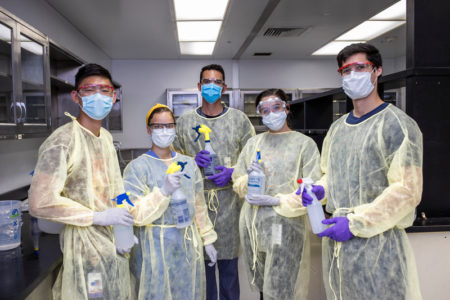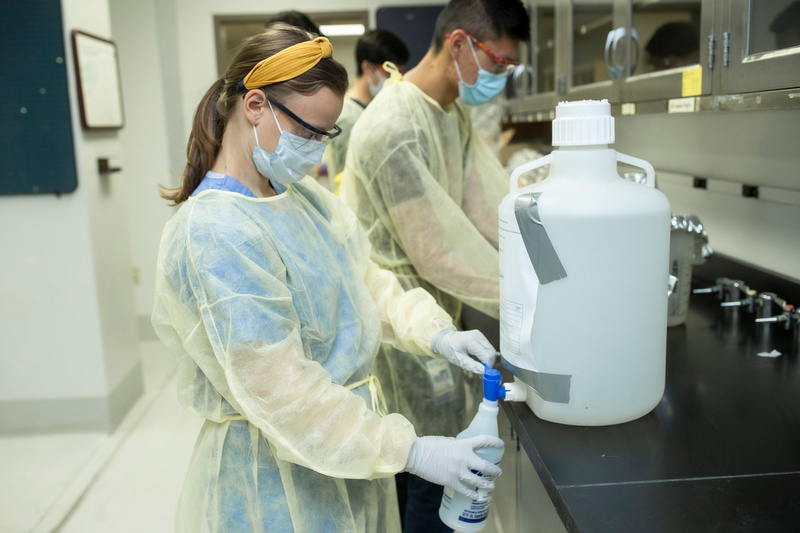Following the tradition of World War II’s Rosie the Riveter, compassionate scientists at UT Health San Antonio and The University of Texas at San Antonio are backfilling the front-lines pandemic effort by making hand sanitizer for UT Health care providers.
“This started with our senior director of clinical operations, who asked if we could augment our supply of hand sanitizer in the clinics,” said Jennifer Sharpe Potter, Ph.D., vice dean for research in the Long School of Medicine at UT Health San Antonio. “We started thinking about what we could do, and a team member said, ‘If only we could make hand sanitizer according to World Health Organization (WHO) guidelines.’ We realized we have people who can help with this, and we got on the phone with one of our basic science department chairs, who said, ‘Let’s do it!’”

Two labs — headed by Chris Walter, Ph.D., professor and chair of the Department of Cell Systems and Anatomy; Ann Griffith, Ph.D., assistant professor in the Department of Microbiology, Immunology and Molecular Genetics; and Dave Cavazos, Ph.D., Dr. Walter’s colleague — made the first batches. Following the WHO-approved recipe, they used high-purity alcohol, hydrogen peroxide, glycerol and water.
After Dr. Potter texted them about the project, UTSA chemistry professors Stanton McHardy, Ph.D., and Doug Frantz, Ph.D., made large batches, as well, and delivered them to UT Health San Antonio, where staff from the Department of Facilities Management were diverted from their regular jobs to go to the laboratory. “I showed our facilities team, mobilized by Associate Vice President Daniel Costello, how to dispense the sanitizer aseptically, and they filled more than 200 bottles with the hand sanitizer that Dr. Frantz and Dr. McHardy had put together at UTSA,” Dr. Walter said.
“They never thought their job description was making hand sanitizer, but everyone stood up and did it,” Dr. Potter said.
Students from the Long School of Medicine joined the bottle-filling effort, as well.

Dr. Walter and her colleagues made sure the process is safe and that no one’s health will be at risk from using the internally made sanitizer. “The ingredients in our laboratories are better than what most people have at home,” Dr. Walter said. “The alcohol we have is more than 98% pure, for example, which is definitely of higher quality than the rubbing alcohol people keep at home.”
Glycerol helps hold the sanitizer on the hands long enough for the alcohol to kill germs.
Can the public buy some of this hand sanitizer? “We can’t make that much,” Dr. Walter said. “We’re not a production facility. We’re just doing this to try to help our front-line workers.”
Patients at UT Health Physicians, the clinical practice of the Long School of Medicine, use wall-mounted stations, stand-alone stick stations and bottles to dispense vendor-made hand sanitizer, said Casey Peterson, senior director of clinical operations for the practice. The laboratory-made hand sanitizer is supplementing the supply that providers and staff use in the clinics. “I absolutely trust our researchers, and we are depending on them to augment our supply,” Peterson said.
The lab-made hand sanitizer is being used at all locations of UT Health Physicians, including the Medical Arts and Research Center, UT Health Hill Country, UT Health Verde Hills, UT Health Shavano, UT Health Medical Drive, UT Health Westover Hills and the Mays Cancer Center, home to UT Health San Antonio MD Anderson Cancer Center.
“We have all these wonderful scientists who want to do their part to support our health care workers,” Dr. Potter said. “Dr. Walter didn’t have to do this, and Dr. Frantz and Dr. McHardy at UTSA certainly didn’t have to do this. But they are partners in science with us, and now they are partners in helping us on the front lines.”
It’s certainly reminiscent of a World War II effort in the spirit of Rosie the Riveter.
# # #
The University of Texas Health Science Center at San Antonio, also referred to as UT Health San Antonio, is one of the country’s leading health sciences universities and is designated as a Hispanic-Serving Institution by the U.S. Department of Education. With missions of teaching, research, patient care and community engagement, its schools of medicine, nursing, dentistry, health professions and graduate biomedical sciences have graduated more than 37,000 alumni who are leading change, advancing their fields, and renewing hope for patients and their families throughout South Texas and the world. To learn about the many ways “We make lives better®,” visit www.uthscsa.edu.
Stay connected with The University of Texas Health Science Center at San Antonio on Facebook, Twitter, LinkedIn, Instagram and YouTube.


